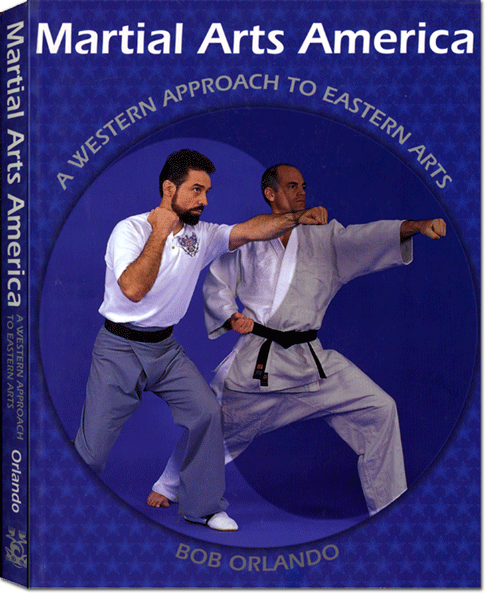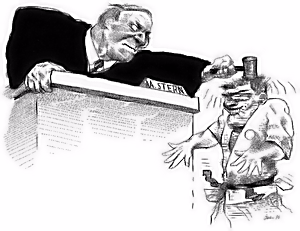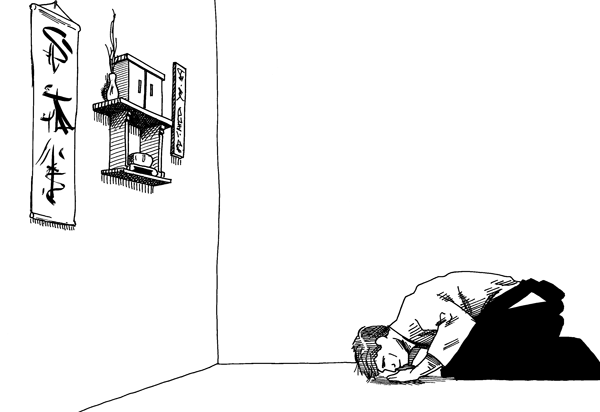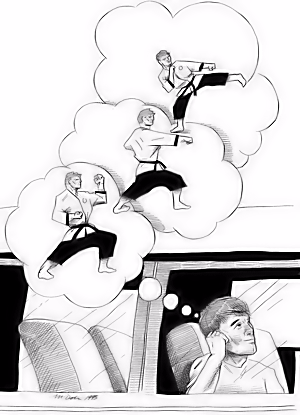
The Zen master brings his pupil to enlightenment, not by exposition, explanation, or example. Rather, it is carried out by posing a puzzle (known as a koan), by silence in response to a question, or by a slap in response to an answer.
Spiritual Training as Part of Martial Art StudyThere are, within the martial art community, those who contend that omission of the religious, spiritual, and meditative elements from martial art instruction limits the practitioner's training and development: both as a martial artist and as a contributing member of society. They note that in many culturally Western martial art schools today, very few value the role of formal Eastern meditation, either as a method of self-discovery or as a means of enlightenment.In an article in a scholarly martial art magazine, Michael Maliszewski (1992, 1:36), for example, disparages the fact that many consummate Western martial artists – highly skilled and accomplished individuals – immerse themselves in the physical side of their respective arts, all the while perfectly content to ignore (and in some cases, deliberately exclude) the art's religious and spiritual elements. Martial art publications, he notes, are replete with stories of individuals who are attracted to the arts solely for self-defense. In this, he is correct. However, it is also his contention that those pursuing martial art study for this reason alone suffer from feelings of inadequacy, physical impotence, and inferiority. He acknowledges that the meditative, religious, and spiritual elements are not necessary to produce technically proficient practitioners; however, he contends that individuals so trained remain psychologically immature and incapable of dealing with conflict in non-violent ways. His argument is not new – extreme, but not new. Others before him have likewise complained that the wrongs in American martial arts today are directly attributable to this lack of a contemplative and meditative component in martial art training. But are our shortcomings "directly attributable" to this omission? Is there any evidence supporting the contention that inclusion of spiritual instruction produces better, more socially responsible martial artists? Without a doubt, American martial arts have their share of problems, but so do their Asian counterparts. For all of the ethereal instruction Asian practitioners supposedly receive, they, too, are plagued with their share of unscrupulous instructors, unruly practitioners, splits and divisive factions in their organizations, power politics among their leaders, and a jingoistic attitude toward non-Asian students that rivals anything in the United States. If Eastern meditation, as a method of self-discovery and a means of enlightenment, works no better than this in its own culture, then I have little hope for its effectiveness in our very different Western culture.
Avoiding Religious and Spiritual ElementsRecall for a moment the opening quotation from Geoff Gleeson in the Introduction.When a skill or sport is transferred to another country, that country should replace the foreign training methods with methods reflecting and exploiting its own characteristics, needs, and virtues. Gleeson's Rule, as I call it, is the central truth running through this book. The preceding chapters make a strong case for adopting this rule in our physical training. Practical application of the same rule in the spiritual dimension means that those training in Saudi Arabia, for example, draw from that nation's Muslim heritage and faith. Formal spiritual instruction and meditative practice there should conform to Islam's culture and customs. In Israel, practitioners would incorporate training methods compatible with Jewish practices and tradition. Likewise, in the United States, we replace incompatible foreign training methods with those that reflect our own "community" characteristics, needs, and virtues. In America, however, this is much more difficult than it sounds. Most Heterogeneous Nation Our closest competitor for the MHN designation is, perhaps, Indonesia. The fifth most populous nation in the world, Indonesia has more than 300 distinct people groups. Culturally, Indonesia is the most diverse of the nations of the East. Certainly she is much more diverse than the very homogenous nations of China, Japan, and Korea – nations from which most of America's more popular martial arts have come. Partly because of past European colonial ambitions, and partly because military and economic alliances there foster greater cultural movement and integration, Europe today, has a more heterogeneous population than many nations of the East – certainly the Far East. Many European countries, for example, have sizable emigrant communities. France has very large African and Asian populations, and Germany has one of the largest Turkish communities outside Turkey. The Netherlands, Great Britain, and other European nations can all make similar claims. Still, when it comes to multicultural diversity, all of these pale in comparison to America's immigration legacy. I point this out not to say that American culture is better or worse than any other, but only to say that ours is very different and substantially more diverse than any in the East. Given this ethnic diversity and multicultural perspective, I believe that there are some very compelling reasons why American martial artists pursue physical excellence in their arts – to the exclusion of Eastern spiritual, religious, and meditative elements. American cultural diversity affords its citizens unparalleled access to more than just different fighting arts. We also have a wealth of world religions and philosophies that we are guaranteed, by our constitution, the freedom to examine and explore. We may, for example, freely pursue Hinduism, Buddhism, Islam, Judaism, Christianity, atheism, humanism, naturalism, and every other 'ism' in between. All of this apart from the art. Americans have an abundance of social, cultural, intellectual, philosophical, spiritual and religious avenues available to them: self-help programs, college courses in ethnic studies, and religious and spiritual instruction, just to name a few. With all of this available to him, the American martial artist may avoid the religious and spiritual elements inherent in Eastern martial arts simply because he already feels that his spiritual needs are adequately addressed through any one of these other venues. Equally important in a pluralistic and multicultural society is the recognition that what is acceptable for some is culturally taboo for others. For example, the martial art practitioner may distance himself from the art's spiritual and religious components because they are – from his culture's perspective – forbidden. The practicing Muslim, orthodox Jew, or evangelical Christian may rightly pursue martial art study and training for self-defense, health, or sport reasons; however, his religious laws and beliefs are generally incompatible with Eastern religious teaching.1 Because of this incompatibility, many practitioners of Western faiths (and for that matter, members of any number of other religions) are prohibited from participating in the religious or spiritual aspects of Eastern martial arts. Focus on Physical Excellence
The contention that martial art study and practice devoid of the religious, spiritual, and meditative elements leaves practitioners "psychologically immature and incapable of dealing with conflict in nonviolent ways" is wrong. It is wrong because it fails to consider the untold numbers of practitioners who, by virtue of their efforts and subsequent accomplishments through physical training, are very mature and more than capable of dealing with conflict in nonviolent ways. Although there are many other reasons why martial art instructors avoid this spiritual side of the art, I will share only one more: adjunctive training. Adjunctive Instruction? In Chapter 5, I addressed the issue of learning a foreign language as part of martial art instruction – for instance, learning Japanese in a karate school. Despite a student's best efforts at learning and pronouncing such things as kiba-dachi, mae-geri, and seiken chudan uchiuke gedan-barai,2 he still would not know enough Japanese to locate even a lavatory. Under the constant tutelage of qualified language teachers and eight-hour-a-day lessons, it takes months of formal instruction, followed by decades of practice, to master another language. Given these realities, can we really expect to achieve spiritual enlightenment through even the best adjunctive lip service?
Martial Art Spiritual Training – Adding Value?Recognizing that lasting spiritual enlightenment is simply not possible when approached in such a superficial manner, we are still left with the question, "Is there any value to formal spiritual instruction in modern martial art training?" I think the answer is yes and no. For those pursuing the art for reasons other than self-defense, probably, yes. But what of those students who are paying their hard-earned money for martial art instruction?Even eliminating those instructors who spend time teaching the spiritual side of the art simply to cover their lack of knowledge or skill in the physical area, we are still left with the fact that every minute spent on spiritual development is one less moment spent in practical physical instruction. If, for example, I enroll in a firearms class for self-protection, I expect to learn something of the legal limitations, ramifications, and ethical consequences of defending life and property with deadly force. I expect this. I do not, however, expect to receive instruction in self-discovery and enlightenment. Neither do martial artists.
Where does all of this leave the Western student? How does he handle routine school or dojo practices that have religious connotations? Well, in Chapter 5, I addressed one of them: bowing. There, I pointed out how bowing before a school shrine or alter may be seen by some as a sign of reverence or religious obeisance to another spiritual leader or guide. To American students of Muslim and Jewish faiths, this practice is not simply acquainting yourself with another culture's traditions; it is nothing short of partaking in a forbidden religious practice. Since it was covered before, I will not rehash the issue further. However, another much more common Eastern religious practice is meditation. Meditation and Visualization Meditation in some schools is really little more than visualization. Visualization, because of its use by New Age groups, has really received an undeserved bad reputation. However, using imagination to train physical skills violates none of the principles or teachings of the Koran or Jewish and Christian religious texts. It is, therefore, completely acceptable to teach meditation as a tool to perfect technique, to rehearse and mentally practice, and to focus your mind and attention in a positive, productive, and practical way. Presented in this manner – without the weight of spiritual or religious significance – meditation is a useful and acceptable training tool.
Morality and Spiritual Need High intellectual and moral standards are required of teacher and student alike. Spiritual awareness and the need to realize one's essential nature by attaining optimal intellectual and spiritual development are much more important than any physical skill we may ever develop. Where, then, is the balance? How do conscientious teachers of martial arts pass on their formidable physical skills in a responsible way, without imposing their personal beliefs on those who may not want them? How do we share our spiritual beliefs with those who do wish to hear them without stepping on the toes of others? Like many instructors, I believe we do this first by example. As teachers, we exercise a degree of authority and influence over those who choose to train and study with us. However, the fact remains that our students will follow our examples farther than they will ever follow our words. Wielding influence effectively means demonstrating our personal spiritual and religious convictions in our everyday lives. If, in that effort, my students notice something different in me, and question it, then I tell them frankly and openly what it is. If they wish to know more, then I make time – outside our martial training – to share with them the source of my conviction, strength, and inner peace. This presents, I believe, a fuller, life-size portrait of exactly how the dedicated martial artist lives and functions as a contributing member of society.
Replacing Form with FunctionAs humans we are simultaneously physical, intellectual, and spiritual beings. As such, we need exercise to keep us both physically and mentally fit. We need intellectual stimulation and challenge to stay sharp and improve our powers of perception and reason. Most important, we need awareness of the infinitely greater forces that exist around us.Given the importance of the spiritual dimension, its deeply personal nature, and the complexities of sharing one's religious beliefs in our multicultural, pluralistic, and highly diverse social environment, perhaps the best application of Gleeson's Rule is one that replaces form with function. Instead of bringing formal meditation and other Eastern religious trappings into Western martial art study and training, try sharing your religious or spiritual beliefs by personal example. Honestly living them before your pupils will have a much greater impact on their lives than any amount of formal instruction. Special thanks to Mr. Kurt Frankenburg, a teacher of martial arts whose enthusiasm is encouraging, and whose wisdom far exceeds his years. |
|
Footnotes:
|
|
©Copyright Bob Orlando, 1993-2016 All rights reserved. |
http://www.OrlandoKuntao.com
E-mail: Ron@OrlandoKuntao.com |
Last update:
Aug. 6, 2016 by Bob Orlando |



